Combined fragment is an interaction fragment which defines a combination (expression) of interaction fragments. A combined fragment is defined by an interaction operator and corresponding interaction operands. Through the use of combined fragments the user will be able to describe a number of traces in a compact and concise manner.
Combined fragment may have interaction constraints also called guards in UML 2.4.
Interaction operator could be one of:
- alt - alternatives
- opt - option
- loop - iteration
- break - break
- par - parallel
- strict - strict sequencing
- seq - weak sequencing
- critical - critical region
- ignore - ignore
- consider - consider
- assert - assertion
neg - negative
Interaction Constraint
An interaction constraint is a constraint used in interactions - a Boolean expression that guards an operand in a combined fragment.
An interaction constraint is shown in square brackets covering the lifeline where the first event occurrence will occur, positioned above that event, in the containing interaction or interaction operand.
UML 2.4 often refers to interaction constraint as a guard.Alternatives
The interaction operator alt means that the combined fragment represents a choice or alternatives of behavior. At most one of the operands will be chosen. The chosen operand must have an explicit or implicit guard expression that evaluates to true at this point in the interaction.
An implicit true guard is implied if the operand has no guard.
An operand guarded by else means a guard that is the negation of the disjunction of all other guards. If none of the operands has a guard that evaluates to true, none of the operands are executed and the remainder of the enclosing interaction fragment is executed.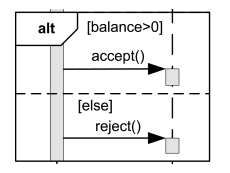
Call accept() if balance > 0, call reject() otherwise.Option
The interaction operator opt means that the combined fragment represents a choice of behavior where either the (sole) operand happens or nothing happens. An option is semantically equivalent to an alternative combined fragment where there is one operand with non-empty content and the second operand is empty.
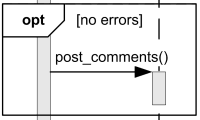
Post comments if there were no errors.Loop
The interaction operator loop means that the combined fragment represents a loop. The loop operand will be repeated a number of times. The loop construct represents a recursive application of the seq operator where the loop operand is sequenced after the result of earlier iterations.
UML 2.4 specification provides weird description of the loop operator with odd examples. I will try to extract here some sense from that.
Loop could be controlled by either or both iteration bounds and a guard.
Loop operand could have iteration bounds which may include a lower and an upper number of iterations of the loop. Textual syntax of the loop is:
loop-operand ::= loop [ ‘(‘ min-int [ ‘,’ max-int ] ‘)’ ]
min-int ::= non-negative-integer
max-int ::= positive-integer | ‘‘
If loop has no bounds specified, it means potentially infinite loop with zero as lower bound and infinite upper bound.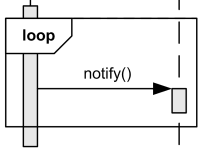
Potentially infinite loop.
If only min-int is specified, it means that upper bound is equal to the lower bound, and loop will be executed exactly the specified number of times.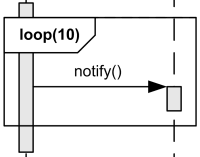
Loop to execute exactly 10 times.
If max-int is specified, it should be greater than or equal to min-int. Loop will iterate minimum the min-int number of times and at most the max-int number of times.
Besides iteration bounds loop could also have an interaction constraint - a Boolean expression in square brackets. To add to the other confusions, UML 2.4 also calls both of them guards.
UML tries to shuffle the simplest form of for loop and *while loop which causes weird UML 2.3 loop semantics on p.488 [UML 2.3 - Superstructure]: “after the minimum number of iterations have executed and the Boolean expression is false the loop will terminate”. This is clarified - though with opposite meaning - on the next page as “the loop will only continue if that specification evaluates to true during execution regardless of the minimum number of iterations specified in the loop.”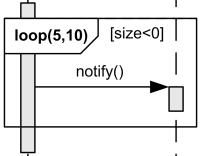
We may guess that as per UML 2.3, the loop is expected to execute
minimum 5 times and no more than 10 times.
If guard condition [size<0] becomes false loop terminates
regardless of the minimum number of iterations specified.
(Then why do we need that min number specified?!)Break
The interaction operator break represents a breaking or exceptional scenario that is performed instead of the remainder of the enclosing interaction fragment.
A break operator with a guard is chosen when the guard is true. In this case the rest of the directly enclosing interaction fragment is ignored. When the guard of the break operand is false, the break operand is ignored and the rest of the enclosing interaction fragment proceeds.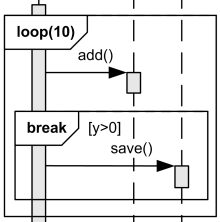
Break enclosing loop if y>0.
A combined fragment with the operator break should cover all lifelines of the enclosing interaction fragment.
Note, UML allows only one level - directly enclosing interaction fragment - to be abandoned. This could become really annoying if double loop or loop with other combined fragments should be broken.
UML 2.3 states that when break operand has no guard, the choice between the break operand and the rest of the enclosing interaction fragment is done “non-deterministically” which most likely means “unpredictable”. Don’t use break without guard.Parallel
The interaction operator par defines potentially parallel execution of behaviors of the operands of the combined fragment. Different operands can be interleaved in any way as long as the ordering imposed by each operand is preserved.
Set of traces of the parallel operator describes all the possible ways or combinations that occurrence specifications of the operands may be interleaved without changing the order within each operand.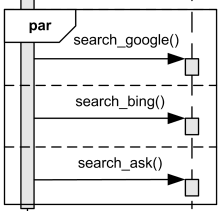
Search Google, Bing and Ask in any order, possibly parallel.
Parallel combined fragment has notational shorthand for the common situations where the order of events on one lifeline is insignificant. In a coregion area of a lifeline restricted by horizontal square brackets all directly contained fragments are considered as separate operands of a parallel combined fragment.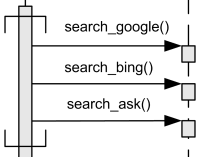
Coregion - search Google, Bing and Ask in any order, possibly parallel.Strict Sequencing
The interaction operator strict requires a strict sequencing (order) of the operands on the first level within the combined fragment.
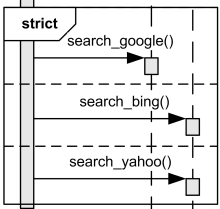
Search Google, Bing and Yahoo in the strict sequential order.
Operands of lower levels within the contained combined fragment will not directly be compared with other occurrence specifications of the enclosing combined fragment. Notationally, this means that the vertical coordinate of the contained fragments is significant throughout the whole scope of the combined fragment and not only on one lifeline.Weak Sequencing
The interaction operator seq means that the combined fragment represents a weak sequencing between the behaviors of the operands.
Weak sequencing is defined by the set of traces with these properties:The ordering of occurrence specifications within each of the operands is maintained.
- Occurrence specifications on different lifelines from different operands may come in any order.
- Occurrence specifications on the same lifeline from different operands are ordered such that an occurrence specification of the first operand comes before that of the second operand.
Weak sequencing reduces to a parallel merge when the operands are on different sets of participants. Weak sequencing reduces to strict sequencing when the operands work on the same participant.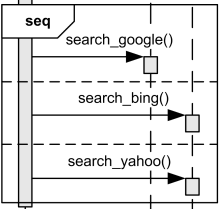
Search Google possibly parallel with Bing and Yahoo, but search Bing before Yahoo.
Critical Region
The interaction operator critical defines that the combined fragment represents a critical region. A critical region is a region with traces that cannot be interleaved by other occurrence specifications (on the lifelines covered by the region). This means that the region is treated atomically by the enclosing fragment and can’t be interleaved, e.g. by parallel operator.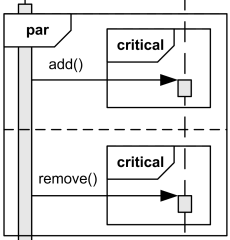
Add() or remove() could be called in parallel,
but each one should run as a critical region.
Ignore
Semantics and the purpose of the interaction operator ignore is obscure. UML 2.3 defines its meaning as “there are some message types that are not shown within this combined fragment. These message types can be considered insignificant and are implicitly ignored if they appear in a corresponding execution. Alternatively, one can understand ignore to mean that the message types that are ignored can appear anywhere in the traces.”
On the other hand, explanations to the Figure 14.25 on p. 530 [UML 2.3 - Superstructure] are that this kind of interaction could be used to specify a test of an existing system. At the runtime the messages ignored in tests “will of course be handled in some manner by the running system”.
The list of ignored messages follows the operand enclosed in a pair of curly braces “{“ and “}”. Ignore operation is typically combined with other operations such as “assert ignore {m, s}.”
Ignore get() and set() messages, if any.
Consider
The interaction operator consider defines which messages should be considered within this combined fragment, meaning that any other message will be ignored.
The list of considered messages follows the operand enclosed in a pair of curly braces “{“ and “}”. Consider operation is typically combined with other operations such as “assert consider {m, s}.”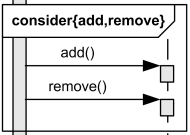
Consider only add() or remove() messages,
ignore any other.
Assertion
The interaction operator assert means that the combined fragment represents the assertion that the sequences of the assert operand are the only valid continuations (must be satisfied by a correct design of the system). All other continuations result in an invalid trace.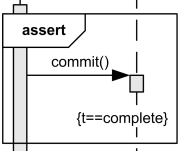
Commit() message should occur at this point,
following with evaluation of state invariant.
Negative
The interaction operator neg describes combined fragment of traces that are defined to be negative (invalid). Negative traces are the traces which occur when the system has failed. All interaction fragments that are different from the negative are considered positive, meaning that they describe traces that are valid and should be possible.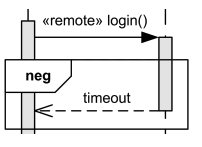
Should we receive back timeout message,
it means the system has failed.
https://www.uml-diagrams.org/sequence-diagrams-combined-fragment.html

